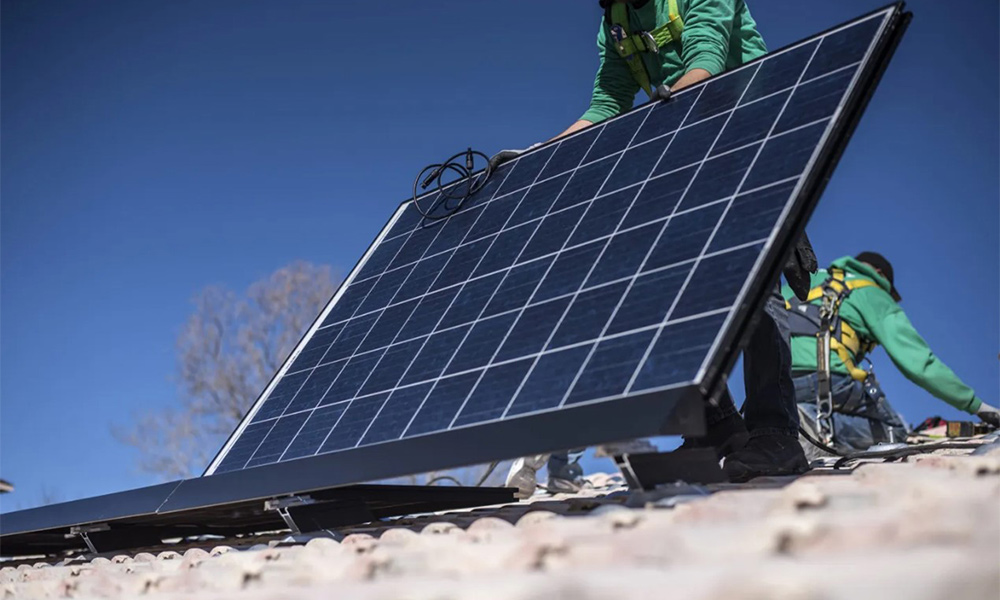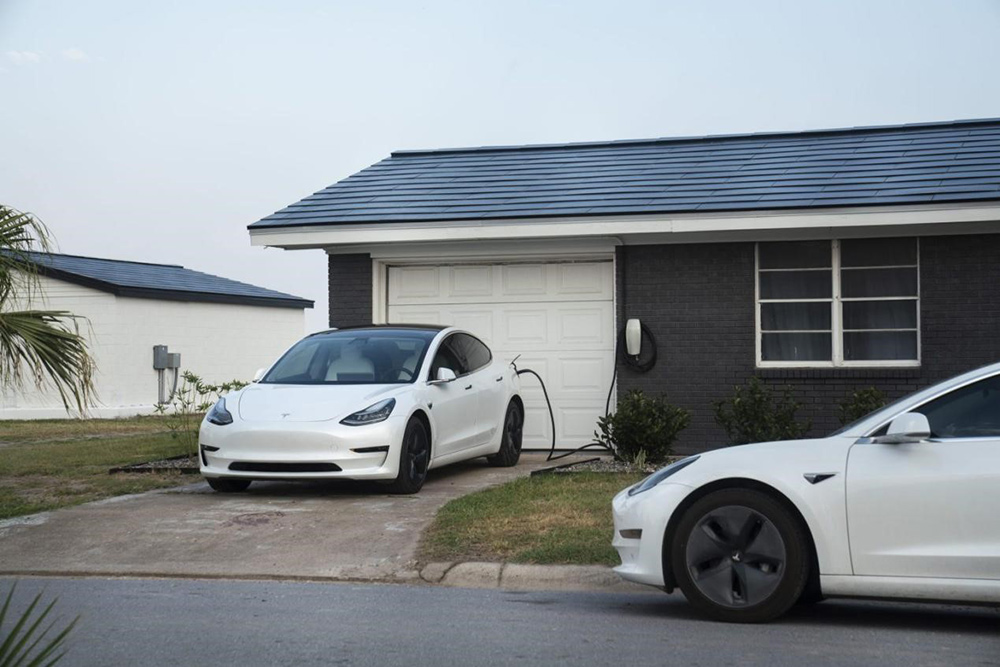
對(duì)于一個(gè)熱衷于大張旗鼓宣傳的企業(yè)家來說,很難想象還有比特斯拉位于紐約州北部的超級(jí)工廠2號(hào)更荒涼的地方了。特斯拉從納稅人手中租用的這個(gè)占地120萬平方英尺(11萬平方米)的綜合設(shè)施,建在一家鋼鐵廠的舊址上,本應(yīng)是整個(gè)西半球同類設(shè)施中最大的,一旦完全建成,每年可生產(chǎn)1000兆瓦的太陽能屋頂和電池板。屆時(shí),龐大的RiverBend廠址將成為其他企業(yè)家的燈塔,為該地區(qū)帶來更多的先進(jìn)制造業(yè)工作崗位。
大約七年后,這里依然燈火通明,但只是勉強(qiáng)亮著。據(jù)伍德麥肯茲公司(Wood Mackenzie)估計(jì),自特斯拉太陽能屋頂這一產(chǎn)品推出以來,其在美國的總安裝量最近才達(dá)到3,000個(gè),發(fā)電量甚至不到區(qū)區(qū)30兆瓦時(shí)。供參考,馬斯克的目標(biāo)是每周安裝1000個(gè)太陽能屋頂。雖然太陽能市場在不斷增長,但所有特斯拉太陽能產(chǎn)品的部署量在過去一年中僅勉強(qiáng)增長了1%,部署容量為348兆瓦,而且到2023年為止,正朝著每年下降近三分之一的方向發(fā)展。其大部分業(yè)務(wù)仍然是銷售傳統(tǒng)的光伏太陽能電池板,缺乏獨(dú)特的賣點(diǎn)或先發(fā)優(yōu)勢。
代表布法羅地區(qū)的州參議員肖恩·瑞安(Sean Ryan)表示,特斯拉位于紐約州北部的超級(jí)工廠2號(hào)的太陽能屋頂和標(biāo)準(zhǔn)電池板產(chǎn)量目前仍然很低,以至于特斯拉不得不雇用低級(jí)別的信息技術(shù)分析師為自動(dòng)駕駛汽車輸入數(shù)據(jù),以達(dá)到就業(yè)指標(biāo)(獲得州政府援助設(shè)定的條件)。

該工廠需要?jiǎng)?chuàng)造約1,500個(gè)工作崗位,否則特斯拉將面臨數(shù)千萬美元的罰款。瑞安告訴《財(cái)富》雜志:“在大規(guī)模支持下,他們一瘸一拐地沖過了終點(diǎn)線。”(特斯拉沒有回應(yīng)置評(píng)請(qǐng)求。)
這些美觀耐用的瓦片于2016年亮相,由經(jīng)過特殊處理的鋼化玻璃制成,既可以用作屋頂板,也可以用作太陽能電池。它們可以抵御高爾夫球大小的冰雹的沖擊,在需要時(shí)可以輕松扣入扣出,方便更換,并提供25年的保修期。與特斯拉Powerwall家用電池儲(chǔ)能系統(tǒng)搭配使用,房主對(duì)這些產(chǎn)品產(chǎn)生和儲(chǔ)存的所有能源贊嘆不已(使用該公司的智能手機(jī)應(yīng)用程序)。簡而言之,這是能源獨(dú)立型家庭的終極早期產(chǎn)品。
事實(shí)上,特斯拉太陽能屋頂很可能會(huì)成為馬斯克最沒有被大肆宣傳的產(chǎn)品,而且他似乎對(duì)銷售這款產(chǎn)品興趣不大。
三位一體的清潔能源
七年前,特斯拉公司斥資26億美元收購了由馬斯克的兩位表兄弟林登·里夫(Lyndon)和彼得·里夫(Peter Rive)創(chuàng)辦的SolarCity,同時(shí),特斯拉太陽能屋頂亮相。當(dāng)時(shí),SolarCity是美國市場的領(lǐng)導(dǎo)者,2016年的裝機(jī)量剛剛超過800兆瓦,是特斯拉去年裝機(jī)量的兩倍多。然而,這筆交易卻飽受爭議。面對(duì)"嚴(yán)重的流動(dòng)性危機(jī)",SolarCity在2015年底陷入困境,并面臨違反貸款契約的風(fēng)險(xiǎn)。由阿肯色州教師養(yǎng)老基金牽頭的集體訴訟稱,馬斯克作為兩家公司的最大股東,擁有約五分之一的有表決權(quán)的股票,可以直接從收購中獲利,并利用自己的影響力迫使特斯拉董事會(huì)施以緊急救助。雖然董事們達(dá)成了庭外和解,但馬斯克不認(rèn)可索賠方案,并于去年在特拉華州衡平法院勝訴。后來,州最高法院維持了這一裁決。
如今,SolarCity的資產(chǎn)被并入了特斯拉,在特斯拉的能源生產(chǎn)和儲(chǔ)存部門中只占很小一部分,由馬斯克三大副手中任職時(shí)間最長的德魯·巴格利諾(Drew Baglino)負(fù)責(zé)。這位特斯拉高級(jí)副總裁的當(dāng)務(wù)之急是提高下一代4680電池的性能,并為馬斯克的核心汽車業(yè)務(wù)部門擴(kuò)大生產(chǎn)規(guī)模;在巴格利諾的待辦事項(xiàng)清單上,解決太陽能問題可能排在很靠后的位置。特斯拉的12.8萬名員工中有多少人為太陽能業(yè)務(wù)工作,這誰也說不準(zhǔn),因?yàn)樵摴局还技径炔渴饠?shù)據(jù),以便讓投資者了解進(jìn)展情況。然而,這很有可能只是舍入誤差。

從理論上講,太陽能完善了馬斯克清潔能源產(chǎn)品的良性循環(huán)——特斯拉用戶擁有一輛電動(dòng)汽車,將汽車插入家用電池充電,然后用溫暖富足的太陽光為所有產(chǎn)品供電,這就是三位一體模式。
KPost的杰恩斯(Jaynes)證實(shí):“我們不會(huì)向那些還沒有電動(dòng)汽車的人大量銷售特斯拉太陽能屋頂。他們往往已經(jīng)加入了這一行列,正在考慮如何進(jìn)入下一個(gè)階段。”
馬斯克經(jīng)常預(yù)測,其價(jià)值39億美元的能源業(yè)務(wù)最終將在規(guī)模和盈利能力上與規(guī)模大得多的汽車業(yè)務(wù)相媲美。去年,汽車業(yè)務(wù)的營收達(dá)到670億美元,毛利率高達(dá)20%。然而,據(jù)未來基金(Future Fund)聯(lián)合創(chuàng)始人兼執(zhí)行合伙人、一直看好特斯拉的知名投資者加里·布萊克(Gary Black)稱,盡管特斯拉的Megapack商用儲(chǔ)能電池業(yè)務(wù)表現(xiàn)超出了投資者的預(yù)期,但太陽能業(yè)務(wù)仍然如此微不足道,以至于大多數(shù)投資者甚至沒有費(fèi)力嘗試對(duì)其業(yè)績進(jìn)行建模。他說:“太陽能是可持續(xù)發(fā)展的下一個(gè)前沿領(lǐng)域,這是因?yàn)槟憧梢杂锰柲芪蓓敒槠嚦潆姟5@是一項(xiàng)艱巨得多的業(yè)務(wù),因?yàn)榇蟛糠止ぷ鞫忌婕鞍惭b。與特斯拉在電動(dòng)汽車領(lǐng)域擁有先發(fā)優(yōu)勢相比,要在這一領(lǐng)域脫穎而出更難。”
太陽能市場正在升溫
得益于30%的聯(lián)邦所得稅抵免、不斷飆升的能源價(jià)格,以及向公用事業(yè)公司出售多余電力的高額上網(wǎng)電價(jià),美國住宅太陽能市場在2022年連續(xù)第六年創(chuàng)下歷史新高,約70萬戶家庭安裝了光伏屋頂,總計(jì)相當(dāng)于6000兆瓦——根據(jù)伍德麥肯茲公司和美國太陽能產(chǎn)業(yè)協(xié)會(huì)(Solar Energy Industries Association)的數(shù)據(jù),其產(chǎn)能每年增加40%。更重要的是,需求強(qiáng)勁的不僅僅是美國。國際能源署(International Energy Agency)認(rèn)為,到2027年,太陽能光伏發(fā)電將超過煤炭,成為世界上最大的發(fā)電來源,因?yàn)樵谶^去10年里,太陽能光伏發(fā)電的成本下降了80%以上。
一些批評(píng)人士(和競爭對(duì)手)認(rèn)為,馬斯克在試圖將特斯拉的藍(lán)圖用于SolarCity時(shí)失算了,因?yàn)樗€沒有意識(shí)到這兩項(xiàng)業(yè)務(wù)有多么不同。
Svea Solar的聯(lián)合創(chuàng)始人埃里克·馬丁森(Erik Martinson)表示:“如果你想一下,與特斯拉流線型汽車業(yè)務(wù)的集中式生產(chǎn)線相反的是,它將提供定制的太陽能屋頂,你必須將所有東西都精確到一英寸,才能完美契合。沒有任何協(xié)同效應(yīng)。”
這位土生土長的瑞典人兼特斯拉Model 3用戶在圣地亞哥生活期間受到了馬斯克的啟發(fā),他說自己曾五次申請(qǐng)為這家汽車制造商工作,但每次都遭到了拒絕。
相反,馬丁森聯(lián)合創(chuàng)立了他自己的太陽能公司,并聲稱其公司已經(jīng)超過了他的榜樣目前每季度60兆瓦太陽能光伏發(fā)電量的平均運(yùn)行率。他說:“今年,我們每季度的發(fā)電量約為75兆瓦,但我們的發(fā)展速度相當(dāng)快,明年我們將把發(fā)電量增加到100兆瓦以上。”在他看來,如果特斯拉是一家獨(dú)立的公司,其太陽能業(yè)務(wù)很可能會(huì)增長得更快。
馬斯克已經(jīng)意識(shí)到,與今年推出的100多萬輛幾乎一模一樣的Model Y汽車不同,安裝太陽能電池以滿足每種需求需要每次都重新發(fā)明車輪。馬斯克在2021年4月承認(rèn):“在評(píng)估某些屋頂?shù)碾y度時(shí),我們基本上犯了一些重大錯(cuò)誤。”他選擇嘗試標(biāo)準(zhǔn)化方法,以便在未來,每個(gè)客戶的房子“在電氣上看起來都一樣,而不是一件獨(dú)特的藝術(shù)品。”
即使在像德克薩斯州這樣電網(wǎng)不穩(wěn)定、不可靠的地方,說服房主勇敢嘗試太陽能也并非易事。這在很大程度上與太陽能屋頂?shù)囊鐑r(jià)有關(guān),平均10千瓦電池陣列的太陽能屋頂(包括固定電池)的價(jià)格輕輕松松就能達(dá)到5萬美元。杰恩斯說,有太多的德克薩斯人每隔幾年就搬一次家,這樣的投資難以獲得回報(bào)。考慮到馬斯克對(duì)廣告持極端懷疑態(tài)度,因此宣傳工作非常困難。他最近一次大張旗鼓地宣傳來吸引媒體關(guān)注還要追溯到2016年10月,當(dāng)時(shí)他首次展示了太陽能屋頂,就在特斯拉股東就其收購SolarCity進(jìn)行投票的幾周之前。
近年來,股東們似乎對(duì)他在人工智能、自動(dòng)駕駛汽車和兩條腿的擎天柱機(jī)器人方面的努力更加感興趣。相比之下,馬斯克的第三個(gè)總體規(guī)劃(其中包括推廣更多太陽能項(xiàng)目)在3月份的投資者日上鎩羽而歸。工匠們爬上屋頂安裝太陽能電池板,如何能與機(jī)器人管家的最終前景競爭?在特斯拉2023年的三次季度財(cái)報(bào)電話會(huì)議中,巴格利諾只有一次提及太陽能業(yè)務(wù)。隨著銷量朝著錯(cuò)誤的方向發(fā)展,馬斯克本人也沒什么興趣,完全避免了這個(gè)問題,這也是可以理解的。
回到紐約州北部,超級(jí)工廠2號(hào)仍在勉強(qiáng)運(yùn)轉(zhuǎn)。特斯拉在該項(xiàng)目的工業(yè)合作伙伴松下(Panasonic)已經(jīng)撤出了該工廠,在此過程中裁減了數(shù)百個(gè)工作崗位。州政府納稅人購買的價(jià)值約2億美元的機(jī)器已被出售或直接報(bào)廢。
瑞安說:"該廠址的復(fù)興具有深刻的象征意義。我們對(duì)這個(gè)項(xiàng)目寄予厚望,并投入了大量的經(jīng)濟(jì)發(fā)展資金,但卻事與愿違。現(xiàn)在我們感到灰心喪氣。”(財(cái)富中文網(wǎng))
譯者:中慧言-王芳
對(duì)于一個(gè)熱衷于大張旗鼓宣傳的企業(yè)家來說,很難想象還有比特斯拉位于紐約州北部的超級(jí)工廠2號(hào)更荒涼的地方了。特斯拉從納稅人手中租用的這個(gè)占地120萬平方英尺(11萬平方米)的綜合設(shè)施,建在一家鋼鐵廠的舊址上,本應(yīng)是整個(gè)西半球同類設(shè)施中最大的,一旦完全建成,每年可生產(chǎn)1000兆瓦的太陽能屋頂和電池板。屆時(shí),龐大的RiverBend廠址將成為其他企業(yè)家的燈塔,為該地區(qū)帶來更多的先進(jìn)制造業(yè)工作崗位。
大約七年后,這里依然燈火通明,但只是勉強(qiáng)亮著。據(jù)伍德麥肯茲公司(Wood Mackenzie)估計(jì),自特斯拉太陽能屋頂這一產(chǎn)品推出以來,其在美國的總安裝量最近才達(dá)到3,000個(gè),發(fā)電量甚至不到區(qū)區(qū)30兆瓦時(shí)。供參考,馬斯克的目標(biāo)是每周安裝1000個(gè)太陽能屋頂。雖然太陽能市場在不斷增長,但所有特斯拉太陽能產(chǎn)品的部署量在過去一年中僅勉強(qiáng)增長了1%,部署容量為348兆瓦,而且到2023年為止,正朝著每年下降近三分之一的方向發(fā)展。其大部分業(yè)務(wù)仍然是銷售傳統(tǒng)的光伏太陽能電池板,缺乏獨(dú)特的賣點(diǎn)或先發(fā)優(yōu)勢。
代表布法羅地區(qū)的州參議員肖恩·瑞安(Sean Ryan)表示,特斯拉位于紐約州北部的超級(jí)工廠2號(hào)的太陽能屋頂和標(biāo)準(zhǔn)電池板產(chǎn)量目前仍然很低,以至于特斯拉不得不雇用低級(jí)別的信息技術(shù)分析師為自動(dòng)駕駛汽車輸入數(shù)據(jù),以達(dá)到就業(yè)指標(biāo)(獲得州政府援助設(shè)定的條件)。
動(dòng)力循環(huán):馬斯克設(shè)想了特斯拉的三位一體模式,即電動(dòng)汽車由電池充電,而電池又由公司的太陽能電池板供電。
該工廠需要?jiǎng)?chuàng)造約1,500個(gè)工作崗位,否則特斯拉將面臨數(shù)千萬美元的罰款。瑞安告訴《財(cái)富》雜志:“在大規(guī)模支持下,他們一瘸一拐地沖過了終點(diǎn)線。”(特斯拉沒有回應(yīng)置評(píng)請(qǐng)求。)
這些美觀耐用的瓦片于2016年亮相,由經(jīng)過特殊處理的鋼化玻璃制成,既可以用作屋頂板,也可以用作太陽能電池。它們可以抵御高爾夫球大小的冰雹的沖擊,在需要時(shí)可以輕松扣入扣出,方便更換,并提供25年的保修期。與特斯拉Powerwall家用電池儲(chǔ)能系統(tǒng)搭配使用,房主對(duì)這些產(chǎn)品產(chǎn)生和儲(chǔ)存的所有能源贊嘆不已(使用該公司的智能手機(jī)應(yīng)用程序)。簡而言之,這是能源獨(dú)立型家庭的終極早期產(chǎn)品。
事實(shí)上,特斯拉太陽能屋頂很可能會(huì)成為馬斯克最沒有被大肆宣傳的產(chǎn)品,而且他似乎對(duì)銷售這款產(chǎn)品興趣不大。
三位一體的清潔能源
七年前,特斯拉公司斥資26億美元收購了由馬斯克的兩位表兄弟林登·里夫(Lyndon)和彼得·里夫(Peter Rive)創(chuàng)辦的SolarCity,同時(shí),特斯拉太陽能屋頂亮相。當(dāng)時(shí),SolarCity是美國市場的領(lǐng)導(dǎo)者,2016年的裝機(jī)量剛剛超過800兆瓦,是特斯拉去年裝機(jī)量的兩倍多。然而,這筆交易卻飽受爭議。面對(duì)"嚴(yán)重的流動(dòng)性危機(jī)",SolarCity在2015年底陷入困境,并面臨違反貸款契約的風(fēng)險(xiǎn)。由阿肯色州教師養(yǎng)老基金牽頭的集體訴訟稱,馬斯克作為兩家公司的最大股東,擁有約五分之一的有表決權(quán)的股票,可以直接從收購中獲利,并利用自己的影響力迫使特斯拉董事會(huì)施以緊急救助。雖然董事們達(dá)成了庭外和解,但馬斯克不認(rèn)可索賠方案,并于去年在特拉華州衡平法院勝訴。后來,州最高法院維持了這一裁決。
如今,SolarCity的資產(chǎn)被并入了特斯拉,在特斯拉的能源生產(chǎn)和儲(chǔ)存部門中只占很小一部分,由馬斯克三大副手中任職時(shí)間最長的德魯·巴格利諾(Drew Baglino)負(fù)責(zé)。這位特斯拉高級(jí)副總裁的當(dāng)務(wù)之急是提高下一代4680電池的性能,并為馬斯克的核心汽車業(yè)務(wù)部門擴(kuò)大生產(chǎn)規(guī)模;在巴格利諾的待辦事項(xiàng)清單上,解決太陽能問題可能排在很靠后的位置。特斯拉的12.8萬名員工中有多少人為太陽能業(yè)務(wù)工作,這誰也說不準(zhǔn),因?yàn)樵摴局还技径炔渴饠?shù)據(jù),以便讓投資者了解進(jìn)展情況。然而,這很有可能只是舍入誤差。
硬電池:房主們對(duì)特斯拉的太陽能屋頂贊不絕口,但每次安裝費(fèi)用約為5萬美元,因此尚未得到廣泛應(yīng)用。
從理論上講,太陽能完善了馬斯克清潔能源產(chǎn)品的良性循環(huán)——特斯拉用戶擁有一輛電動(dòng)汽車,將汽車插入家用電池充電,然后用溫暖富足的太陽光為所有產(chǎn)品供電,這就是三位一體模式。
KPost的杰恩斯(Jaynes)證實(shí):“我們不會(huì)向那些還沒有電動(dòng)汽車的人大量銷售特斯拉太陽能屋頂。他們往往已經(jīng)加入了這一行列,正在考慮如何進(jìn)入下一個(gè)階段。”
馬斯克經(jīng)常預(yù)測,其價(jià)值39億美元的能源業(yè)務(wù)最終將在規(guī)模和盈利能力上與規(guī)模大得多的汽車業(yè)務(wù)相媲美。去年,汽車業(yè)務(wù)的營收達(dá)到670億美元,毛利率高達(dá)20%。然而,據(jù)未來基金(Future Fund)聯(lián)合創(chuàng)始人兼執(zhí)行合伙人、一直看好特斯拉的知名投資者加里·布萊克(Gary Black)稱,盡管特斯拉的Megapack商用儲(chǔ)能電池業(yè)務(wù)表現(xiàn)超出了投資者的預(yù)期,但太陽能業(yè)務(wù)仍然如此微不足道,以至于大多數(shù)投資者甚至沒有費(fèi)力嘗試對(duì)其業(yè)績進(jìn)行建模。他說:“太陽能是可持續(xù)發(fā)展的下一個(gè)前沿領(lǐng)域,這是因?yàn)槟憧梢杂锰柲芪蓓敒槠嚦潆姟5@是一項(xiàng)艱巨得多的業(yè)務(wù),因?yàn)榇蟛糠止ぷ鞫忌婕鞍惭b。與特斯拉在電動(dòng)汽車領(lǐng)域擁有先發(fā)優(yōu)勢相比,要在這一領(lǐng)域脫穎而出更難。”
太陽能市場正在升溫
得益于30%的聯(lián)邦所得稅抵免、不斷飆升的能源價(jià)格,以及向公用事業(yè)公司出售多余電力的高額上網(wǎng)電價(jià),美國住宅太陽能市場在2022年連續(xù)第六年創(chuàng)下歷史新高,約70萬戶家庭安裝了光伏屋頂,總計(jì)相當(dāng)于6000兆瓦——根據(jù)伍德麥肯茲公司和美國太陽能產(chǎn)業(yè)協(xié)會(huì)(Solar Energy Industries Association)的數(shù)據(jù),其產(chǎn)能每年增加40%。更重要的是,需求強(qiáng)勁的不僅僅是美國。國際能源署(International Energy Agency)認(rèn)為,到2027年,太陽能光伏發(fā)電將超過煤炭,成為世界上最大的發(fā)電來源,因?yàn)樵谶^去10年里,太陽能光伏發(fā)電的成本下降了80%以上。
一些批評(píng)人士(和競爭對(duì)手)認(rèn)為,馬斯克在試圖將特斯拉的藍(lán)圖用于SolarCity時(shí)失算了,因?yàn)樗€沒有意識(shí)到這兩項(xiàng)業(yè)務(wù)有多么不同。
Svea Solar的聯(lián)合創(chuàng)始人埃里克·馬丁森(Erik Martinson)表示:“如果你想一下,與特斯拉流線型汽車業(yè)務(wù)的集中式生產(chǎn)線相反的是,它將提供定制的太陽能屋頂,你必須將所有東西都精確到一英寸,才能完美契合。沒有任何協(xié)同效應(yīng)。”
這位土生土長的瑞典人兼特斯拉Model 3用戶在圣地亞哥生活期間受到了馬斯克的啟發(fā),他說自己曾五次申請(qǐng)為這家汽車制造商工作,但每次都遭到了拒絕。
相反,馬丁森聯(lián)合創(chuàng)立了他自己的太陽能公司,并聲稱其公司已經(jīng)超過了他的榜樣目前每季度60兆瓦太陽能光伏發(fā)電量的平均運(yùn)行率。他說:“今年,我們每季度的發(fā)電量約為75兆瓦,但我們的發(fā)展速度相當(dāng)快,明年我們將把發(fā)電量增加到100兆瓦以上。”在他看來,如果特斯拉是一家獨(dú)立的公司,其太陽能業(yè)務(wù)很可能會(huì)增長得更快。
馬斯克已經(jīng)意識(shí)到,與今年推出的100多萬輛幾乎一模一樣的Model Y汽車不同,安裝太陽能電池以滿足每種需求需要每次都重新發(fā)明車輪。馬斯克在2021年4月承認(rèn):“在評(píng)估某些屋頂?shù)碾y度時(shí),我們基本上犯了一些重大錯(cuò)誤。”他選擇嘗試標(biāo)準(zhǔn)化方法,以便在未來,每個(gè)客戶的房子“在電氣上看起來都一樣,而不是一件獨(dú)特的藝術(shù)品。”
即使在像德克薩斯州這樣電網(wǎng)不穩(wěn)定、不可靠的地方,說服房主勇敢嘗試太陽能也并非易事。這在很大程度上與太陽能屋頂?shù)囊鐑r(jià)有關(guān),平均10千瓦電池陣列的太陽能屋頂(包括固定電池)的價(jià)格輕輕松松就能達(dá)到5萬美元。杰恩斯說,有太多的德克薩斯人每隔幾年就搬一次家,這樣的投資難以獲得回報(bào)。考慮到馬斯克對(duì)廣告持極端懷疑態(tài)度,因此宣傳工作非常困難。他最近一次大張旗鼓地宣傳來吸引媒體關(guān)注還要追溯到2016年10月,當(dāng)時(shí)他首次展示了太陽能屋頂,就在特斯拉股東就其收購SolarCity進(jìn)行投票的幾周之前。
近年來,股東們似乎對(duì)他在人工智能、自動(dòng)駕駛汽車和兩條腿的擎天柱機(jī)器人方面的努力更加感興趣。相比之下,馬斯克的第三個(gè)總體規(guī)劃(其中包括推廣更多太陽能項(xiàng)目)在3月份的投資者日上鎩羽而歸。工匠們爬上屋頂安裝太陽能電池板,如何能與機(jī)器人管家的最終前景競爭?在特斯拉2023年的三次季度財(cái)報(bào)電話會(huì)議中,巴格利諾只有一次提及太陽能業(yè)務(wù)。隨著銷量朝著錯(cuò)誤的方向發(fā)展,馬斯克本人也沒什么興趣,完全避免了這個(gè)問題,這也是可以理解的。
回到紐約州北部,超級(jí)工廠2號(hào)仍在勉強(qiáng)運(yùn)轉(zhuǎn)。特斯拉在該項(xiàng)目的工業(yè)合作伙伴松下(Panasonic)已經(jīng)撤出了該工廠,在此過程中裁減了數(shù)百個(gè)工作崗位。州政府納稅人購買的價(jià)值約2億美元的機(jī)器已被出售或直接報(bào)廢。
瑞安說:"該廠址的復(fù)興具有深刻的象征意義。我們對(duì)這個(gè)項(xiàng)目寄予厚望,并投入了大量的經(jīng)濟(jì)發(fā)展資金,但卻事與愿違。現(xiàn)在我們感到灰心喪氣。”(財(cái)富中文網(wǎng))
譯者:中慧言-王芳
For an entrepreneur who thrives on loud and splashy promotion, it’s hard to imagine a more forlorn spot than Tesla’s upstate New York “Gigafactory 2.” Built on the former grounds of a steel mill, the 1.2-million-square-foot complex, which Tesla leases from the taxpayer, was supposed to be the largest facility of its kind in the entire Western hemisphere, capable of producing 1,000 megawatts of solar roofs and panels annually once fully scaled. The massive RiverBend site would then serve as a beacon to other entrepreneurs, attracting more advanced manufacturing jobs to the area.
Some seven years later the lights are still on—but just barely. Wood Mackenzie estimated aggregate Tesla Solar Roof installations in the U.S. just recently hit 3,000 since the product launched—not even enough to produce a measly 30 megawatts of electricity in total. For context, Musk had aspired to a goal of installing 1,000 roofs per week. While the solar market grows, deployments of all Tesla solar products barely eked out a 1% increase in the past year, deploying 348 MW of capacity—and so far in 2023 it is tracking toward an annual decline of nearly a third. The bulk of its business remains selling conventional photovoltaic (PV) solar panels, where it lacks a unique selling point or first mover edge.
Solar Roof and standard panel production at its Gigafactory 2 in upstate New York now remains so low that Tesla had to hire low-level IT analysts inputting data for self-driving cars, says Sean Ryan, a state senator representing the Buffalo area, just to hit employment targets imposed as conditions for receiving state aid.
Around 1,500 jobs needed to be created at the site lest Tesla be subject to fines in the tens of millions of dollars. “They limped over the finish line and only with a lot of help,” Ryan tells Fortune. (Tesla did not respond to a request for comment.)
Unveiled in 2016, these elegant and durable tiles made from a specially treated tempered glass serve as both shingles and solar cells. They can withstand the impact of golf-ball-size hail, snap in and out for easy replacement if needed, and come with a 25-year warranty. Paired with a Tesla Powerwall residential battery, homeowners can marvel at all the energy they generate and store using the company’s smartphone app. In short, it’s the ultimate early adopter product for the energy-independent household.
Indeed, the Tesla Solar Roof may very well earn the distinction of being Musk’s most under-hyped product—as well as one he appears to have little interest in selling.
The holy trinity of clean energy
The unveiling of Tesla’s Solar Roof coincided precisely with the brand’s entry into the market seven years ago through the $2.6 billion acquisition of SolarCity, founded by two of Musk’s cousins, Lyndon and Peter Rive. At the time it was the U.S. market leader with just over 800 MW installed in 2016, more than twice what Tesla achieved last year. Yet controversy dogged the deal. Facing a “major liquidity crisis,” SolarCity was in dire straits by the end of 2015 and risked breaching loan covenants. A class action lawsuit led by Arkansas’s teachers pension fund argued that Musk, as the largest shareholder of both companies with roughly a fifth of the voting stock, stood to profit directly from the acquisition and used his influence to strong-arm Tesla’s board into a bailout. While the directors settled out of court, Musk fought the claims and won in Delaware’s chancery court last year. The state supreme court later affirmed the ruling.
Nowadays SolarCity’s assets are folded into Tesla where they constitute only a minor part of its energy generation and storage segment, answerable to Drew Baglino, the longest serving of Musk’s top three lieutenants. The Tesla senior vice president’s immediate priority is improving the performance of his next-gen 4680 battery cells and scaling their production for Musk’s core automotive segment; fixing solar is likely very far down on Baglino’s to-do list. How many of Tesla’s 128,000 employees work for its solar business is anyone’s guess, since the company publishes only a quarterly deployment figure to keep investors apprised of its progress. Chances are, however, it’s not much more than a rounding error.
In theory, solar completes Musk’s virtuous circle of clean energy products—a holy trinity where Tesla customers own an EV, plug the car into their household battery to recharge, and power everything with the warm bountiful glow of the sun’s rays.
“We don’t sell a lot of Tesla Solar Roofs to people that don’t already have an electric vehicle,” KPost’s Jaynes confirms. “They tend to already be on the bandwagon and are looking at how to go to the next level.”
Musk has often predicted his $3.9 billion energy operations will eventually grow to rival in size and profitability its much larger autos business, which generated $67 billion in revenue and a gross margin in the high 20s last year. Yet while its Megapack commercial battery storage business outperforms investor expectations, solar specifically remains so insignificant that most investors don’t even bother trying to model its results, according to Gary Black, cofounder and managing partner of the Future Fund and a well-known Tesla bull. “It is the next frontier of sustainability, because you can use your Solar Roof to charge your car,” he says. “But it’s a much tougher business since a lot of it is installation. And it’s harder to differentiate yourself than in EVs, where Tesla has a first mover advantage.”
The solar market is heating up
Thanks to a 30% federal income tax credit, soaring energy prices, and often generous feed-in tariffs for selling excess power to utilities, the U.S. residential solar market enjoyed its sixth consecutive record year in 2022, and some 700,000 homeowners had a photovoltaic roof installed, equating to a grand total of six gigawatts—a 40% annual increase in production capacity, according to Wood Mackenzie and the Solar Energy Industries Association. More important, it’s not just the U.S. experiencing strong demand. The International Energy Agency argues solar PV will overtake coal by 2027 to become the largest source of power generation in the world now that costs have dropped more than 80% in the past decade.
Some critics (and competitors) think that Musk miscalculated in trying to use the Tesla blueprint at SolarCity—before realizing how different the two businesses are.
“If you think about what might be the opposite of the centralized production lines at Tesla’s streamlined car business, it would be providing custom-made solar roofs where you have to measure everything to the inch to fit perfectly,” says Svea Solar cofounder Erik Martinson. “There’s no synergies whatsoever.”
The native Swede and Tesla Model 3 driver was inspired by Musk during his time living in San Diego and says he applied five separate times to work for the carmaker—receiving a rejection every single time.
Instead Martinson cofounded his own solar energy company and claims it already surpassed his role model’s current average run-rate of 60 MW of solar PV capacity per quarter. “This year we’re doing about 75 megawatts per quarter, but we’re growing quite rapidly, so next year we will increase that to over 100 megawatts,” he says. In his view, Tesla’s solar business might very well grow faster were it a stand-alone company.
Musk has already tried to course correct after realizing that—unlike the over 1 million virtually identical Model Y cars stamped out in cookie-cutter fashion this year—installing solar PVs to fit each and every need required reinventing the wheel each time. “We basically made some significant mistakes in assessing the difficulty of certain roofs,” Musk conceded back in April 2021, opting to try to standardize the approach so that in future, each customer’s house “l(fā)ooks the same electrically instead of being a unique work of art.”
And persuading homeowners to take the leap into solar isn’t an easy sell, even in places like Texas that have a shaky and unreliable power grid. A lot of that has to do with the premium price that can easily run to $50,000 for a Solar Roof with an average 10 kilowatt array including stationary battery. Far too many Texans move every few years to make such an investment pay off, Jaynes said. And spreading the word is difficult given that Musk is extremely skeptical of advertising. His last big push for media attention came all the way back in October 2016 when he first presented the Solar Roof, a few short weeks before Tesla shareholders were due to vote on his SolarCity acquisition.
And in recent years, shareholders have seemed far more keen on his endeavors in artificial intelligence, self-driving cars, and two-legged Optimus droids. By comparison Musk’s third Master Plan, which included a pitch for more solar, landed with a thud on Investor Day in March. How can craftsmen clambering up on rooftops to install panels compete for attention next to the eventual promise of robot butlers? During all three of its 2023 quarterly earnings calls, the subject of Tesla’s solar business was broached only once—by Baglino. With volumes trending in the wrong direction, Musk himself understandably had little appetite and avoided the issue entirely.
Back in upstate New York, the Gigafactory 2 sputters on, just barely. Tesla’s industrial partner in the project, Panasonic, has already pulled out of the site, eliminating hundreds of jobs in the process. Some $200 million worth of machinery bought by state taxpayers has since been sold off or simply scrapped.
“The resurrection of that site was deeply symbolic,” Ryan said. “We pinned a lot of hopes and a good deal of economic development funds on this one project, which turned out to be a failed silver bullet. Now we feel deflated.”






